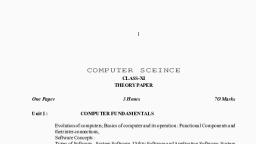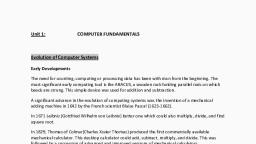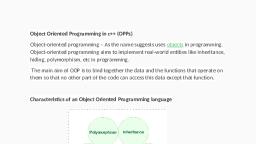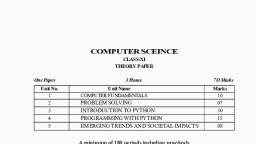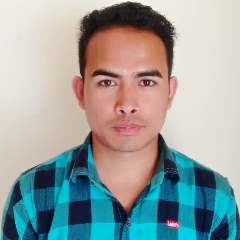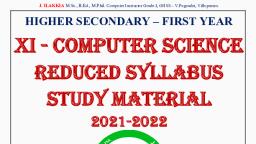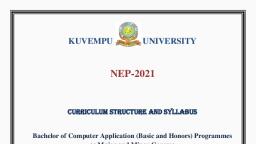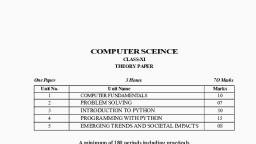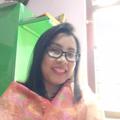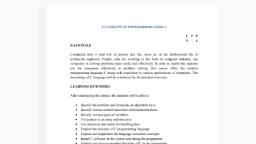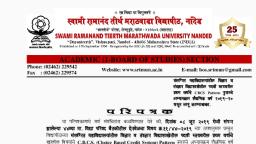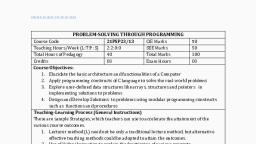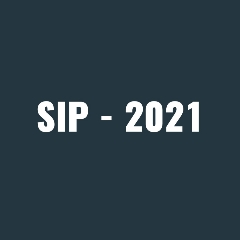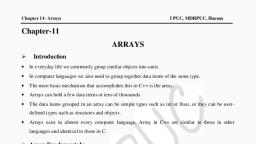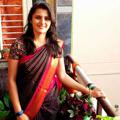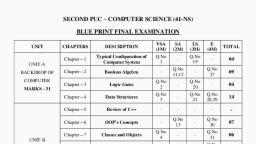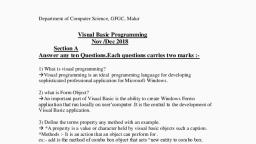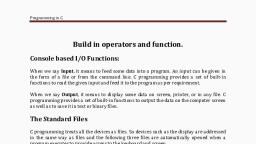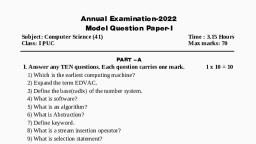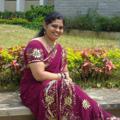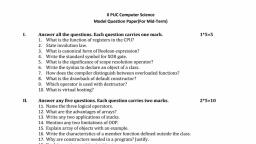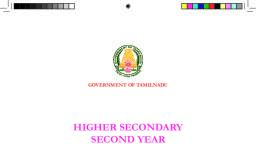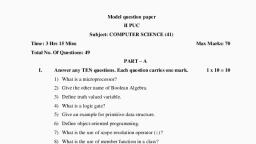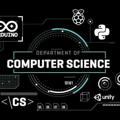Page 1 :
1, , COMPUTER, , SCEINCE, , CLASS-XI, THEORY PAPER, One Paper, Unit 1 :, , Unit 2 :, , Unit 3 :, , 3 Hours, , 7O Marks, , COMPUTER FUNDAMENTALS, Evolution of computers; Basics of computer and its operation : Functional Components and, their inter-connections,, Software Concepts :, Types of Software - System Software, Utility Software and Application Software; System, Software : Operating System, Compilers, Interpreters and Assembler; Operating System : Need, for operating system, Functions of Operating System (Processor Management, Memory, Management, File Management and Device Management), Types of operating system :, Interactive (GUI based), Time Sharing, Real Time and Distributed;, Note : The above-mentioned Operating System specific tasks can be illustrated and implemented, using any operating system., PROGRAMMING METHODOLOGY, General Concepts; Modular approach; Clarity and Simplicity of Expressions, Use of Proper, Names for identifiers, Comments, Indentation; Documentation and Program Maintenance;, Running and Debugging Programs, Syntax Errors, Run-Time Errors, Logical Errors;, Problem Solving Methodology and Techniques : Understanding of the problem, Identifying, minimum number of inputs required for output, Step by step solution for the problem, breaking, down solution into simple steps, Identification of arithmetic and logical operations required for, solution, Using Control Structure : Conditional control and looping (finite and infinite);, INTRODUCTION TO PROGRAMMING IN C++, Programming by Example In C++ Language :, C++ character set, C++ Tokens (Identifiers, Keywords, Constants, Operators), Structure of a, C++ Program (include files, main function); Header files - iostream.h, iomanip.h; cout, cin;, Use of I/O operators (<< and >>), Use of endl and setw(), Cascading of I/O operators, Error, Messages; Use of editor, basic commands of editor, compilation, linking and execution; standard, input/output operations from C language : gets(), puts() of stdio.h header file;, Data Types, Variable and Constrants :, Concept of Data types; Built-in Data types : char, int, float and double, Constants : Integer, Constants, Character Constants (Backslash Character constants : \n,\t,), Floating point Constants,, String Constants, Variables of built-in data types, Access Modifier : const; Variables of built-in, data types, Declaration/Initialisation of variables, Assignment statement; Type modifiers : signed,, unsigned, long;
Page 2 :
2, Operators and Expressions :, Operators : Arithmatic operators (−,+,*,/,%), Unary operator (-), Increment and Decrement, Operator (−−,++), Relational Operators, (>,> =, <,<,==,!=), Logical operators (!,&&,||),, conditional operator : <condition>?<if ture>:<else>; Precedence of Operators; Expressions;, Automatic Type conversion in expressions, Type casting; C++ shorthands (+=,−=,*=,/=,%=);, Flow of control :, Conditional statements : if-else, Nested if, switch.. case.. default, Nested switch.. case,, break statement (to be used in switch.. case only); Loops : while, do-while, for and Nested, loops;, Structured Data Type : Array, Declaration/Initialisation of one dimensional array, Inputting array elements, Accessing array, elements, Manipulation of Array elements (sum of elements, product of elements, average of, elements, linear search, finding maximum/minimum value);, Declaration/Initialisation of a String, string manipulations (counting vowels/consonants/digits/, special characters, case conversion, reversing a string) : String and characters related library, functions., isalnum(), isalpha(), isdigit(), islower(), isupper(), tolower(), toupper(), strcpy(), strcat(),, strlen(), strcmp(), strcmpi();, Declaration/Initialisation of a two-dimensional array, inputting array elements, Accessing array, elements, Manipulation of Array elements (sum of row element, column elements, diagonal, elements, finding maximum/minimum values);, Unit 4 :, , COMPUTER SYSTEM ORGANISATION, Number System : Binary, Octal, Decimal, Hexadecimal and conversion between two different, number systems, Integer, Floating Point, 2's complement of number from base-2;, Internal Storage encoding of Characters : ASCII, ISCII (Indian scripts Standard Code for, Information Interchange), UNICODE;, Microprocessor : Basic concepts, Clock speed (MHz, GHz), 16 bit, 32 bit, 64 bit processors;, Types-CISC, RISC; Concept of System Buses, Address bus, Data bus,, Types of Memory : Cache (L1, L2), Buffer, RAM (DRAM, SDRAM, RDRAM, DDRAM),, ROM (PROM, EPROM), Acess Time;, Power supply : Switched Mode Power Supply (SMPS) : Elementary Concept of Power Supply, : Voltage, Current, Power (Volt, Ampere, Watt), SMPS supplies - Mother Board, Hard Disk, Drive, Floppy Disk, Drive, CD/DVD Drive; Power conditioning Devices : Voltage Stabilizer,, Constant Voltage Transformer (CVT), Uninterrupted Power Supply (UPS) - online and offline., ——§§§——
Page 3 :
3, , COMPUTER SCIENCE, CLASS XI, PRACTICAL, One Paper, , 3 Hours, , Unit, 1., , 30 Marks, Marks, , Programming in C++, , 10, , One programming problem in C++ to be developed and tested in Computer, During the examination. Marks are alloted on the basis of following :, Logic, :, 5 Marks, Documentation/Indentation, :, 2 Marks, Output presentation, :, 3 Marks, Notes : The types of problems to be given will be of application type from the, following topics :, 2., , Project work, , 10, , (As mentioned in general guidelines for project, given at the end of the, curriculum), 3., , Practical File, , 05, , Must have minimum 15 programs from the topics covered in Class XI course., 4., , Viva voce, , 05, , Viva will be asked from syllabus covered in class XI and the project developed, by the student., , ——§§§——
Page 4 :
4, , COMPUTER, , SCEINCE, , CLASS-XII, THEORY PAPER, One Paper, , 3 Hours, , 7O Marks, , Unit 1 : PROGRAMMIN IN C++Object Oriented Programming :, Concept of Object Oriented Programming - Data hiding, Data encapsulation, Class and Object,, Abstract class and Concrete class, Polymorphism (Implementation of polymorphism using Function, overloading as an example in C++); Inheritance, Advantages of Object Oriented Programming, over earlier programming methodologies,, Implementation of Object Oriented Programming Concepts in C++ :, Definition of a class, Members of a class - Data Members and Member Functions (methods),, Using Private and Public visibility modes, default visibility mode (private); Member function, definition : inside class definition and outside class definition using scope resolution operator (::);, Declaration of objects as instances of a class; accessing members from object (s), Array of type, class, Objects as function arguments - pass by value and pass by reference;, Constructor and Destructor :, Constructor : Special Characteristics, Declaration and Definition of a constructor, Default, Constructor, Overloaded Constructors, Copy Constructor, Constructor with default argumnets;, Destructor : Special Characteristics, Declaration and definition of destructor; Inheritance (Extending, Classes) : Concept of Inheritance, Base Class, Derived Class, Defining derived classes, protected, visibility mode; Single level inheritance, Multilevel inheritance and Multiple inheritance, Privately, derived, Publicity derived and Protectedly derived class, accessibility of members from objects, and within derived class(es);, Pointers :, Declaration and Initialization of Pointers; Dynamic memory allocation/deallocation operators :, new, delete; Pointers and Arrays : Arraly of Pointers, Pointer to an array (1 dimensional array),, Function returning a pointer, Reference variables and use of alias; Function call by reference., Pointer to structures : Deference operator *,->; self referencial structures;, Unit 2 : DATA STRUCTURES, Arrays :, One dimensional array : Traversal, Searching (Linear, Binary Search), Insertion of an element in, an array, deletion of an element from an array, Sorting (Insertion, Selection, Bubble sort)., Two-dimensional arrays : Finding sum/difference of two NxM arrays containing numeric values,, Interchanging Row and Column elements in a two dimensional array;, Stack (Array and Linked implementation of Stack) :, Operations on Stack (PUSH and POP) and its Implementation in C++, Converting expressions, from INFIX to POSTFIX notation and evaluation of Postfix expression;
Page 5 :
5, , Unit 3 : DATABASES AND SQL, Database Concepts :, Relational data model : Concept of domain, tuple, relation, key, primary key, alternate key,, candidate key;, Relational algebra : Selection, Projection, Union and Cartesian product;, Structured Query Language :, SQL commands :, CREATE TABLE, DROP TABLE, ALTER TABLE, UPDATE .... SET ...., INSERT, DELETE;, SELECT, DISTINCT, FROM, WHERE, IN, BETWEEN, GROUP BY, HAVING, ORDER, BY; SQL functions : SUM, AVG, COUNT, MAX AND MIN;, Note : Implementation of the above mentioned commands could be done on any SQL supported, software., Unit 4 : BOOLEAN ALGEBRA, Evolution of Boolean algebra, Binary-valued Quantities, Boolean Variable, Boolean Constant, and Boolean Operators : AND, OR, NOT; Truth Tables; Closure Property, Commutative Law,, Associative Law, Identity law, Inverse law, Principle of Duality, Idempotent Law, Distributive, Law, Absorption Law, Involution law, DeMorgan's Law and their applications;, Basic Logic Gates (NOT, AND, OR, NAND, NNOR) and their use in circuits., Unit 5 : COMMUNICATION AND NETWORK CONCEPTS, Evolution of Networking : ARPANET, Internet, Interspace; Different ways of sending data across, the network with reference to switching techniques;, Transmission media : Twisted pair cable, coaxial cable, optical fiber, infrared, radio link, microwave, link and satellite link., Different Topologies - Bus, Star, Tree; Concepts of LAN, WAN, MAN;, Electronic Mail, Chat, Video Conferencing; Network Security Concepts : Cyber Law, Firewall,, Cookies, Hackers and Crackers;, Web Pages; Hyper Text Markup Language (HTML), extensible Markup Language (XML);, Hyper Text Transfer Protocol (HTTP); Domain Names; URL; Protocol Address : Website, Web, browser, Web Servers; Web Hosting., ——§§§——
Page 6 :
6, , COMPUTER SCIENCE, CLASS XII, PRACTICAL, One Paper, , 3 Hours, , Unit No., , Unit Name, , 30 Marks, Marks, , 1., , Programming in C++, 10, One programming problem in C++ to be developed and tested in Computer During the, examination. Marks are alloted on the basis of following :, Logic, :, 5 Marks, Documentation/Indentation, :, 2 Marks, Output presentation, :, 3 Marks, Notes : The types of problems to be given will be of application type from the following, topics, •, Arrays (One dimensional and two dimensional), •, Array of structure, •, Stack using arrays and linked implementation, •, Queue using arrays (circular) linked implementation, •, Binary File operations (Creation, Displaying, Searching and modification), •, Text File operations (Creation, Displaying and modification), , 2., , SQL Commands, 05, Five Query questions based on a particular Table/Realtion to be tested practically on Computer, during the examination. The command along with the result must be written in the answer, sheet., , 3., , Project Work, 05, The project has to be developed in C++ language with Object Oriented Technology and, also should have use of Data files., •, Presentation on the computer, •, Project report (Listing, Sample, Outputs, Documentation, •, Viva, , 4., , Practical File, 05, Must have minimum 20 programs from the following topics, •, Arrays (One dimensional and two dimensional, sorting, searching, merging, deletion, & insertion of elements), •, Arrays of structures, Arrays of Objects, •, Stacks using arrays and linked implementation
Page 7 :
7, , •, Queues using arrays (linear and circular) and linked implementation, •, File (Binary and Text) operations (Creation, Updation, Query), •, Any computational based problems, 15 SQL commands along with the output based on any table/relation :, 5., , Viva Voce, 05, Viva will be asked from syllabus covered in class XII and the project developed by student., , GUIDELINES FOR PROJECTS (Class XI and XII), 1., , Preamble, , 1.1, , The academic course in Computer Science includes one Project in each year. The Purpose behind, this is to consolidate the concepts and practices imparted during the course and to serve as, a record of competence., , 1.2, , A group of two/three students as team may be allowed to work on one project., , 2., , Project content, , 2.1, , Project for class XI can be selected from one of the topics given in event programming., , 2.2, , Project for class XII should ensure the coverage of following areas of curriculum :, a. Problem Solving, b. Data Structure, c. Object Oriented Programming in C++, d. Data File Handling, Theme of the project can be, • Any subsystem of a System Software or Tool, • Any Scientific or a fairly complex algorithmic situation, • Business oriented problems like Banking, Library information system., Hotel or Hospital management system, Transport query system, • Quizzes/Games;, • Tutor/Computer Aided Learning Systems, , 2.3, , The aim of the project is to highlight the abilities of algorithmic formulatin, modular programming,, optimized code preparation, systematic documentation and other associated aspects of Software, Development., , 2.4, , The assessment would be through the project demonstration and the Project Report, which should, portray Programming Style, Structured Design, Minimum Coupling, High Cohesion, Good documentation, of the code to ensure readability and ease of maintenance., , PRESCRIBED TEXTBOOK FOR CLASS XI :, Computer Science for class XI, By : Preeti Gehlot & Charu Gupta,, Published by : Oxford University Press
Page 8 :
8, , PRESCRIBED TEXTBOOK FOR CLASS XII :, Computer Science for class XII, By : Preeti Gehlot, Charu Gupta,, Published by : Oxford University Press, REFERENCE BOOKS : FOR CLASSES XI AND XII, Computer Organisation and boolean Algebra, 1. Rajaraman, FUNDAMENTALS OF COMPUTERS, Prentice Hall of India., 2. C.W. Gear, COMPUTER ORGANISATION AND PROGRAMMING, McGraw Hill Publishing., 3. A.P. Malvino, DIGITAL COMPUTER FUNDAMENTALS, Tata McGraw Hill Publishing Co.Ltd., 4. J. Shelly & Roger Hunt, COMPUTER STUDIES, Wheeler's Publication., 5. C.S. French, COMPUTER STUDIES, Arnold Publishers., 6. Thomas C. Bartee, DIGITAL COMPUTER FUNDAMENTALS, McGraw Hill International., Problem Solving and Programming in C++, Note : Prior knowledge of C is not required in the learning of C++, even though reference, about C are made in some of the books., 1. Robert Lofore, OBJECT ORIENTED PROGRAMMING IN TURBO C++, Galgotia Publication, Pvt. Ltd., 2. David Parsons, OBJECT ORIENTED PROGRAMMING WITH C++, BPB Publication., 3. Bjarne Stroutrup, THE C++ PROGRAMMING LANGUAGE, Adison Wesley., 4. AI Stevens, TEACH YOUR SELF C++ TECHNIQUES & APPLICATIONS, BPB Publications., 5. Scott Robert Ladd, TURBO C++ TECHNIQUES & APPLICATIONS, BPB Publications., Operating Environment, 1. Ritchi, Operating Systems, BPB Publications., 2. James L. Peterson &Abraham S., OPERATING SYSTEM,Addision-Wesley Publishing Company., Data Structures, 1. M.A., Weiss, Data Structures and Algorithm Analysis in C++, the Benjamin/Cummings Pub. Co.,, Inc., 2. Scott Robert Ladd, C++ COMPONENTS AND ALGORITHMS, BPB Publications., Database Management System and SQL, 1. Martin Gruber, UNDERSTANDING SQL, BPB Publications., 2. Sheldon M. Dunn x Base Cross Reference Handbook, First Authorised Asian Edition 93,, Tech. Publications Pvt. Ltd., 3. C.J. Data, DATABASE PRIMER, Adison Wesley.
Page 9 :
9, Computer Network, 1. A.S. Tanenbaum, Computer Network, Prentice Hall of India P. Ltd., 2. Williams Stalling, Data Communication and Networks, Prentice Hall of India P. Ltd., 3. Hancock, Network Concept and Architecture, BPB Publications., Reference Magazines, PC WORLD, COMPUTER TODAY, PC QUEST, DATA QUEST, COMPUTER WORLD., Reference Manuals, OPERATING SYSTEM MANUAL, C++ COMPILER MANUAL, , ——§§§——
Page 10 :
DESIGN OF QUESTION PAPER, Subject, Paper, Class, Full Mark, Time, , I., , : COMPUTER SCIENCE, :, :, :, :, , Theory, XI, 70, 3 Hours, , WEIGHTAGE TO OBJECTIVES :, Objectives, Knowledge (K), Understanding (U), Application (A), Skill (S), Total :, , WEIGHTAGE TO FORM OF QUESTIONS :, Form of Questions, No. of Questions, Essay/Long Answer (E/LA), 4, Short Answer (SA-I), 5, II., Short Answer (SA-II), 10, Very Short Answer (VSA), 10, MCQ, 5, Total :, 34, WEIGHTAGE TO CONTENTS :, Unit, Topics, 1, Computer Fundamentals, III. 2, Programming Mythology, 3, Introduction to Programming in C++, 4, Computer System Organisation, , Time (in minutes), 60, 30, 50, 30, 10, 180, , Marks, 21, 32, 14, 3, 70, , Percentage, 30, 46, 20, 4, 100, , Marks, 20, 15, 20, 10, 5, 70, , Percentage, 29, 21, 29, 14, 7, 100, , Total :, IV. SCEHEME OF SECTION :, SCHEME OF OPTION :, V., DIFFICULTY LEVEL, Difficult, VI., Average, Easy, Abbreviation :, , Marks, 10, 6, 40, 14, 70, , Nil, Internal option may be given in Essay Type Questions and SA I (4 question ), only., , :, : 20% marks, : 50% marks, : 30% marks, , K(Knowledge), U(Understanding ), C(Comprehension), Exp.(Expression), (S)Skill, ,, E(Essay Type), SA (Short Answer Type), VSA (Very Short Answer Type),, MCQ(Multiple Choice Question)
Page 11 :
DESIGN OF QUESTION PAPER, Subject, Paper, Class, Full Mark, Time, , I., , :, , COMPUTER SCIENCE, , :, :, :, :, , Theory, XII, 70, 3 Hours, , WEIGHTAGE TO OBJECTIVES :, Objectives, Knowledge (K), Understanding (U), Application (A), Skill (S), Total :, , WEIGHTAGE TO FORM OF QUESTIONS :, Form of Questions, No. of Questions, Essay/Long Answer (E/LA), 4, Short Answer (SA-I), 5, II., Short Answer (SA-II), 10, Very Short Answer (VSA), 10, MCQ, 5, Total :, 34, WEIGHTAGE TO CONTENTS :, Unit, Topics, 1, Programming in C++, 2, Data Structures, III., 3, Database & SQL, 4, Boolean Algebra, 5 Communication & Network Concepts, , Time (in minutes), 60, 30, 50, 30, 10, 180, , Marks, 21, 32, 14, 3, 70, , Percentage, 30, 46, 20, 4, 100, , Marks, 20, 15, 20, 10, 5, 70, , Percentage, 29, 21, 29, 14, 7, 100, , Total :, IV. SCEHEME OF SECTION :, SCHEME OF OPTION :, V., , Marks, 26, 16, 10, 10, 8, 70, , Nil, Internal option may be given in Essay Type Questions and SA I (4 question ), only., , DIFFICULTY LEVEL, :, Difficult :, 20% marks, VI., Average : 50% marks, Easy, : 30% marks, Abbreviation :, , K(Knowledge), U(Understanding ), C(Comprehension), Exp.(Expression), (S)Skill, ,, E(Essay Type), SA (Short Answer Type), VSA (Very Short Answer Type),, MCQ(Multiple Choice Question)

